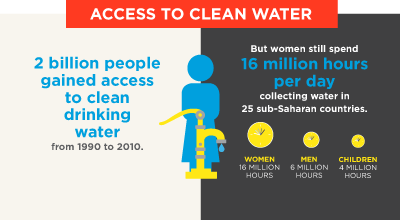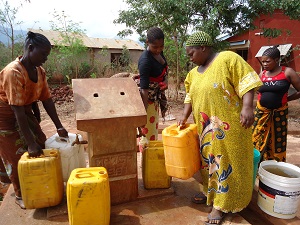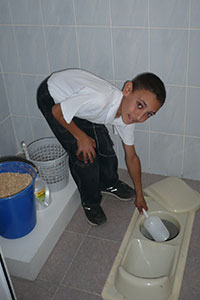SDG 6: Ensure availability and sustainable management of water and sanitation for all

Targets
- By 2030, achieve universal and equitable access to safe and affordable drinking water for all.
- By 2030, achieve access to adequate and equitable sanitation and hygiene for all and end open defecation, paying special attention to the needs of women and girls and those in vulnerable situations.
- By 2030, improve water quality by reducing pollution, eliminating dumping and minimizing release of hazardous chemicals and materials, halving the proportion of untreated wastewater and substantially increasing recycling and safe reuse globally.
- By 2030, substantially increase water-use efficiency across all sectors and ensure sustainable withdrawals and supply of freshwater to address water scarcity and substantially reduce the number of people suffering from water scarcity.
- By 2030, implement integrated water resources management at all levels, including through transboundary cooperation as appropriate.
- By 2020, protect and restore water-related ecosystems, including mountains, forests, wetlands, rivers, aquifers and lakes.
- By 2030, expand international cooperation and capacity-building support to developing countries in water- and sanitation-related activities and programmes, including water harvesting, desalination, water efficiency, wastewater treatment, recycling and reuse technologies.
- Support and strengthen the participation of local communities in improving water and sanitation management.
A drink of water sustains human life, but only if it is safe and affordable. From 1990 to 2015, 2.6 billion people gained access to improved drinking water, but 663 million still rely on unimproved sources like unprotected wells and springs. Water quality has deteriorated through pollution, and worsening scarcity pressures over 40 per cent of the global population [1].

For women, inadequate water supplies pose additional burdens. In a single day in 25 sub-Saharan African countries, women spend 16 million hours collecting water, often to the detriment of schooling or paid work, and with potential health risks from repeatedly carrying heavy burdens over long distances [2].
Poor quality sanitation—including open defecation—can pollute water and spread disease. Sanitation has improved for 2.1 billion people between 1990 and 2015, and open defecation has fallen by nearly half, yet 2.4 billion people still rely on unimproved sanitation facilities. In schools, a lack of separate facilities for girls can be a major reason for parents keeping them at home [3].
Ensuring water and sanitation for all is the goal; achieving it must take all dimensions specific to women and girls on board, and involve them directly in the process.
UN Women acts to provide water and sanitation to all by helping governments craft policies and programmes that respond to women’s needs and underpin sustainable services. Gender-responsive budgeting, for instance, can channel funds towards measures to improve easy access to safe drinking water so that women have more time to earn an income, girls are more likely to attend school, and family health and hygiene improve.
Stories
Tanzanian women bring safe drinking water to their communities
In the Kingolwira village in the United Republic of Tanzania, where water is scarce, women’s leadership and the community-wide construction of a small dam is now ensuring an equitable distribution of clean water.
Women need safe, private toilets
UN Women partners with Women for Water Partnership to promote good practices of women’s leadership in achieving the internationally agreed goals for water and sanitation. This involves supporting women’s networks to sensitize communities and training women to build toilets in their homes.
Notes
[2] World Health Organization and United Nations Children’s Fund, Progress on Drinking Water and Sanitation: 2012 Update, (Geneva, 2012).

